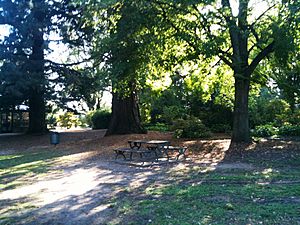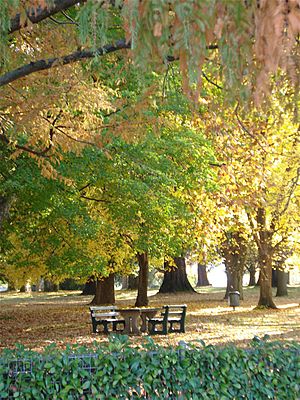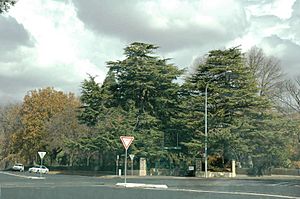Cook Park, Orange facts for kids
Quick facts for kids Cook Park |
|
|---|---|

A picnic bench in Cook Park
|
|
| Type | Urban park |
| Location | 24-26 Summer Street, Orange, City of Orange, New South Wales, Australia |
| Area | 4 hectares (9.9 acres) |
| Created | 1873 |
| Designer | Alfred Patterson |
| Etymology | James Cook |
| Operated by | City of Orange |
| Open | All year |
| Design style | High Victorian |
| Official name: Cook Park; Orange Botanic Garden | |
| Type: | State heritage (landscape) |
| Designated: | 24 August 2018 |
| Reference #: | 1998 |
| Type: | Urban Park |
| Category: | Parks, Gardens and Trees |
| Builders: | Alfred Patterson |
Cook Park is a beautiful park in Orange, New South Wales, Australia. It covers about 4 hectares (10 acres) and is famous for its old trees and lovely gardens. The park was designed by Alfred Patterson and has been a special place for people since 1873. It's so important that it's listed on the New South Wales State Heritage Register. You can find the main entrance at the corner of Summer Street and Clinton Street.
Contents
Why is it Called Cook Park?
The park is named after Captain James Cook. He was a famous British explorer and captain in the Royal Navy. Captain Cook made detailed maps of Newfoundland. He also sailed across the Pacific Ocean three times. During these trips, he was the first European to explore the eastern coast of Australia. He also visited the Hawaiian Islands and sailed all the way around New Zealand.
A Look Back at Cook Park's History
Before Cook Park became a park, it was a place where people camping with their animals would stay in the 1870s. It was known as an old stock reserve.
How the Park Started
The idea for Cook Park came from local people who asked their Member of Parliament for it. In 1853, the land was set aside for houses. But then, in 1854, the whole area was saved from being sold. It was kept as an open space for everyone to enjoy. Even though there were plans for houses in 1860, by 1864, it was marked as a "proposed reserve." In the 1870s, there was another attempt to build on the land, but people asked again to keep it as a park.
The park was officially created in 1873. It was named Cook Park in 1882 to honor Captain James Cook. The area was naturally swampy back then. People even remember catching frogs and tadpoles there in the 1870s!
Early Features and Trees
Around 1882, the park started to take shape. The first trees were planted, including elms, oaks, and redwoods. Some of these trees are now over 120 years old! Lawns, flower beds, and gravel paths were also added. The park began to feature beautiful shrubs, annual flowers, and exotic trees. Many of the original straight paths and rows of trees are still there today.
Cook Park is a great example of a High Victorian style public park. It has paths that spread out from a central spot. Here, you'll find the bandstand and the John Gale Memorial Fountain.
Park Curators and the Cottage
In 1887, Andrew Patterson became the first park curator. He played a big part in developing the park. A small cottage was built for the caretaker that year. Later, a father and son, both named Bastick, served as curators for a total of 90 years! The cottage was named Bastick Cottage in their honor. It was used as a home until the 1970s and is now a craft shop.
The Cannon and the Lake
A cannon in Cook Park came from Sydney in 1870. It was made around 1806 in Scotland during the time of King George III. It weighs about 11 kilograms (24 pounds).
To make the most of the swampy land, a small lake was created in 1890. It has an island in the middle. Today, it's a duck pond where many ducks live. You can also see goldfish and tortoises. Picnic tables and swings are nearby, making it a great spot for families.
Fountains and Gates
The park has many interesting features from the 1890s, like its trees, shrubs, flowers, and two rustic pavilions. The James Dalton Fountain was given to the park in 1891 by James Dalton, a rich merchant from Orange. It's made of cast iron and has water flowing down three levels. You can see four boys with urns and three storks on it. The impressive cast iron gates at the Clinton Street-Summer Street corner were also put up in the 1890s.
Another fountain, the John Gale Memorial Fountain, was added in 1908. It was later updated in the 1920s.
The Bandstand and Conservatory
The beautiful octagonal bandstand opened on March 12, 1908. It has carved wooden details and a tiled roof. The Orange town band decided to build bandstands in Cook and Robertson Parks in 1907. The bandstand still has its original gas fittings and music stands.
During the hard times of the 1930s (the Depression), many projects were done to help people find work. One of these was building a new conservatory and fernery in Cook Park. The Blowes Conservatory was finished in 1934. It was given by Mayor A. Blowes to grow beautiful tuberous begonias. Many of the first plants came from the City of Ballarat. The conservatory is still famous for its amazing begonia displays.
Aviary and Gardens
The original aviary was donated by Dr. Wally Maws, who was Mayor of Orange. It was made bigger in 1995. The fernery, with its lattice design, was finished in 1938. Inside, you'll find the John Gale Memorial Fountain.
Also in 1938, the Frank Mulholland Memorial Garden was created. It's a sunken garden with a sundial, named after a long-serving Town Clerk.
Later Additions and Recognition
In the 1940s, a German "Whiz Bang" Gun was moved to Cook Park. This gun was captured in France during World War I. Many soldiers from the Orange area fought in that battle.
The park has won many awards for its displays. In 1976, the National Trust of Australia (NSW) recognized Cook Park as special. They highlighted the bandstand, fountains, conservatory, main gates, and old trees.
Alfred Patterson: The Park's Designer
Alfred Andrew Patterson (around 1859-1932) was a surveyor and gardener from Sweden. He came to Australia and worked on railways and collected plants. After an illness, he became a gardener for James Dalton in Orange. Thanks to Dalton, he became the head gardener at Cook Park. He also worked at Machattie Park in Bathurst for 20 years.
Both Cook Park and Machattie Park were challenging to develop. Cook Park was built on a swamp! Patterson designed them in the grand Victorian style. This meant wide paths, a pond, a fernery, and tall exotic trees. This style was popular at the time and was familiar to Patterson. These parks were meant to make towns beautiful and show civic pride. Patterson was also asked by the NSW Government to organize flower displays for the Federation celebrations in Sydney.
What You'll See in Cook Park Today

Cook Park covers about 4 hectares (10 acres). It has over 200 trees, some planted as early as the 1870s and 1880s. You'll also find 20 beds of annual flowers.
The park is designed like a wheel, with paths spreading out from a central point. This central spot has the 1908 bandstand and an 1891 cast iron fountain. An avenue of elm trees lines a path in the park's southwest. The park has two impressive cast iron gates at its main street corners, from the 1890s and 1927.
Amazing Trees
Cook Park has a wonderful collection of exotic trees planted since the 1870s. These include different types of elms, oaks, lindens, poplars, redwoods, and cypresses. You can also see two Bunya pines and a Tasmanian blue gum. Some of the oldest trees include:
- English elms
- London planes
- New Zealand cabbage trees
- Lawson cypress
- English oak
- Redwood or big tree (one of the oldest in the park!)
- Himalayan cedars
- Bunya pine
Other mature trees, likely from the 20th century, include:
- Rhododendrons
- Tree tulips
- Pin oaks
- Maidenhair trees
- Blue spruce
- Douglas fir
- Copper beech
- Crepe myrtle
Park Structures and Features
- Structures
- The Bandstand: Built in 1908, it's octagonal with carved wooden pillars and a tiled roof. It still has its original gas fittings and music stands.
- The James Dalton Memorial Fountain: Donated in 1881, this cast iron fountain is on the central path. Water flows down three levels, and it's decorated with figures of boys and storks. It was updated in the 1920s.
- The Ferneries: Built in 1938 and restored in 1988, they house the John Gale Memorial Fountain. This fountain is made of cast iron and features three swans.
- The Blowes Conservatory: Finished in 1934, this building is famous for its yearly display of beautiful begonias.
- The Gates: The most impressive gates are the cast iron ones at the Clinton-Summer Street corner, put up in the 1890s. Another set, moved from Robertson Park in 1927, is at the Summer-Sampson Street corner.
- The Lodge: Built around 1900, this cottage was once home to the park caretakers. It's now used as a craft shop.
- The Frank Mulholland Memorial Garden: This sunken garden with a sundial was dedicated in 1938. It honors a former Town Clerk.
- Other Features: The park also has ponds (from 1890), aviaries (around 1930), and old artillery pieces (from 1870 and 1917). You'll also find many park benches from the early 1900s.
Park Condition and Changes
The park is well-maintained, but some of its very old trees have been damaged by storms. The Lodge building needs some repairs.
Over the years, Cook Park has seen many changes:
- 1883-1887: The basic layout and first plantings were done.
- 1890s: The lake was built, and the main gates were added.
- 1891: The James Dalton Fountain was installed.
- 1920s: The James Dalton Fountain was updated.
- 1927: A second set of gates was moved to the park.
- 1938: The new fernery and conservatory were built. The John Gale Memorial Fountain was moved inside the fernery. The sunken garden was opened.
- 1988: The 1938 fernery was rebuilt.
- 2013-2018: The duck ponds, Dalton Fountain, and Blowes Conservatory were all refurbished.
Why Cook Park is Special
Cook Park is very important because it's a great example of a Victorian-era public park. It's right next to the town's main street and has amazing old trees and many beautiful features. The park was set aside for public use in 1854 and officially became a park in 1873.
The park's design, with paths spreading out like a Union Jack flag, is very special. These paths lead to interesting spots like the bandstand, fountains, conservatory, fernery, ponds, aviaries, and old cannons. The park also shows important projects from the Depression era, like the fernery and conservatory, which were built to help people find work.
Cook Park is a wonderful example of a 19th-century Victorian park. It still has its original layout, old trees, flower beds, and buildings. It's a central and important place for the people of Orange.
Historical Importance
Cook Park is important to the history of New South Wales. It's a very well-preserved example of a Victorian park in a country town. The area was once a camping ground for travelers, and it was set aside as a reserve in 1854. The park was named in 1873, 100 years after Captain James Cook arrived in Australia.
Beautiful Design and Creativity
Cook Park is also important for its beautiful design. It has a classic Victorian style with a central bandstand and fountain, a caretaker's cottage, a conservatory, a fernery, duck ponds, and sunken gardens. The park's features are very well-preserved. The old trees, some of which are rare, are especially suited to Orange's cool climate. The Blowes Conservatory and fernery, built by local residents during the Depression, show great creativity and skill.
Learning from the Past
Cook Park can help us learn more about the history of New South Wales. As an early reserve site, it can still provide information about how the gardens and paths were laid out in the 1890s. It also has importance as an Aboriginal meeting place, linked to the swamps and camping grounds.
Rare Plants and Trees
The park has a collection of rare and old exotic trees from the Victorian period (1890-1920) and later (1920-1940). These trees are quite rare in Australia because they thrive in Orange's cool winters. You won't see them in many other parks in New South Wales.
A Great Example of Parks
Cook Park is a great example of a type of park found in country towns across New South Wales. Other similar parks include Robertson Park in Orange, Machattie Park in Bathurst, and Belmore Park in Goulburn. These parks often have a central location, many exotic trees, a bandstand or performance area, water features, and fountains. Cook Park is a very complete example of this type of Victorian park, with its caretaker's cottage, fernery, duck ponds, conservatory, and beautiful bandstand and fountain.
Images for kids







